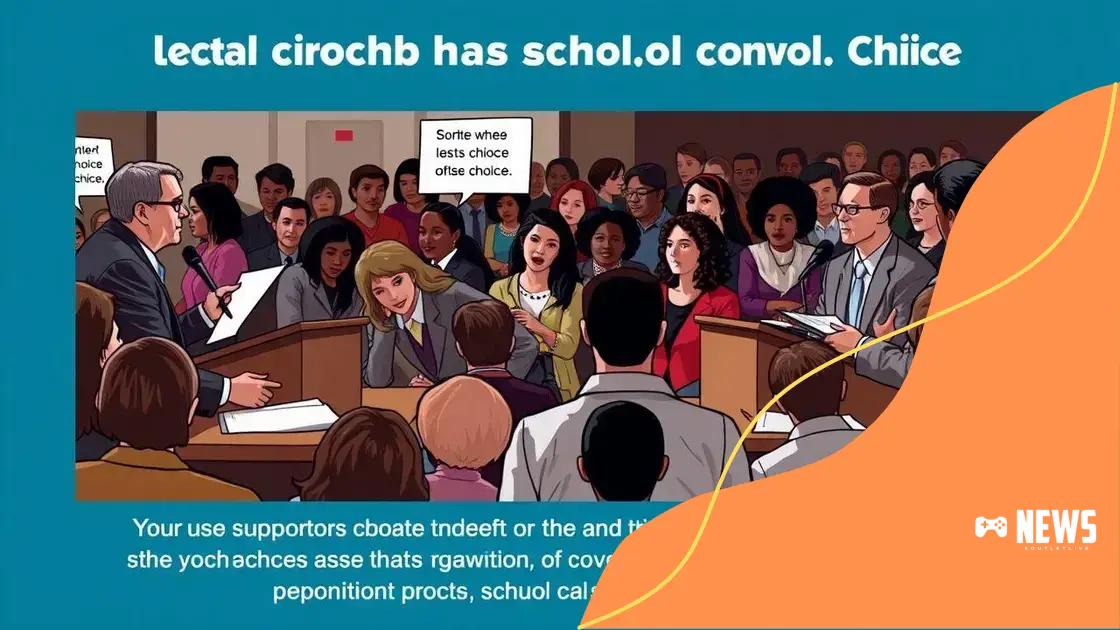School choice expansion in Texas: what you need to know

School choice expansion in Texas provides families with various educational options, allowing them to select schools that better meet their children’s individual needs while impacting public school funding and quality.
School choice expansion in Texas is changing the landscape of education across the state. With various options available, parents can now explore alternatives that better suit their children’s needs. So, what does this mean for families and educators?
Understanding school choice options
Understanding school choice options is essential for parents in Texas. With the recent expansion, families can explore different avenues for their children’s education. School choice can lead to better opportunities that fit individual learning styles and needs.
Types of School Choice Options
There are several options for parents to consider when looking at school choice. These include traditional public schools, charter schools, private schools, and homeschooling. Each type has unique qualities that cater to different educational preferences.
- Traditional Public Schools: Funded by taxpayers, these schools are required to follow state curriculum guidelines.
- Charter Schools: These publicly funded schools operate independently and often use innovative teaching methods.
- Private Schools: Families pay tuition for these schools, which can offer specialized programs and smaller class sizes.
- Homeschooling: Parents take on the responsibility of educating their children at home, allowing for personalized learning.
Another aspect of understanding school choice is recognizing the impact on community schools. Many argue that choices lead to a more competitive environment, which can improve quality across the board. However, others raise concerns about potential funding disparities and access to resources.
Evaluating School Options
When choosing a school, parents should consider various factors, such as academic performance, extracurricular activities, and the school’s culture. Research can lead to informed decisions. Visiting schools and speaking with teachers can provide insight into whether a school aligns with a child’s needs.
In addition, parental involvement plays a crucial role in school success. When parents engage with staff and participate in school events, it often leads to enhanced student performance. Thus, looking into how schools encourage involvement can also aid in making the best choice.
Impact of school choice on families
The impact of school choice on families is significant and multifaceted. As school choice expands, parents find themselves navigating a landscape rich with options that can affect their children’s education and overall family dynamics.
Benefits of School Choice
Many families experience benefits from having various educational options. Choosing a school that fits a child’s needs can lead to improved academic performance and increased satisfaction for both parents and students. Each family can tailor their decision to align with specific goals, whether that’s a focus on academics, arts, or a unique educational philosophy.
- Enhanced Learning Opportunities: Parents can select schools that offer specialized programs, which may better suit their child’s learning style.
- Increased Engagement: Schools that align with family values often encourage more parental involvement, fostering a supportive environment for students.
- Community Connections: Families can connect with like-minded parents, creating networks that support educational journeys.
However, the impact is not solely positive. For some families, the stress of choosing the right school can be overwhelming. Parents often feel pressured to make the best decision for their children, which can lead to anxiety. The feeling of having too many options can create confusion, as families try to weigh the pros and cons of each choice.
Challenges Faced by Families
School choice can also lead to challenges, particularly regarding accessibility and transportation. Not all families have equal access to quality information about their options. Some may find that the best schools are far from home, making commute a significant barrier.Financial considerations can also play a role—private school tuition or costs associated with transportation might not be feasible for everyone.
Finally, the shift in programs can cause a ripple effect. As families make different choices, traditional schools might face declining enrollment, which can lead to fewer resources and decreased funding. This changing dynamic can create tension within the community as schools adapt to new challenges.
The debate around school choice expansion

The debate around school choice expansion is a hot topic among educators, parents, and policymakers. Many people have differing opinions about the effects of giving families more options for their children’s education.
Arguments for School Choice Expansion
Supporters of school choice believe that offering various educational options enhances competition, which can lead to better quality education. They argue that when parents can choose schools, it encourages schools to improve and innovate to attract students.
- Increased Competition: Schools may work harder to improve performance and satisfaction to retain students.
- Personalized Education: Families can find schools that suit their children’s specific needs and learning styles.
- Diverse Educational Approaches: Different schools may offer unique programs based on various philosophies, fostering a broader range of skills and experiences.
Moreover, proponents claim that school choice can empower families by giving them more control over their children’s academic paths. This can increase parental engagement and investment in their child’s education.
Arguments Against School Choice Expansion
On the other hand, critics argue that school choice expansion can lead to negative consequences for public schools. They express concern that increased competition may divert valuable resources away from traditional public schools. As families flock to charter and private schools, public schools can face funding cuts, which can harm students who remain there.
Another significant concern is that not all families have equal access to the same information or resources. Parents in more affluent neighborhoods may have better access to high-quality choices than those in lower-income areas. This disparity can widen the educational achievement gap.
Additionally, the debate often highlights how school choice may not address deeper systemic issues within the education system. Some argue that simply expanding choices does not solve problems related to educational quality or inequity. Instead, they advocate for broader reforms to improve all schools.
How school choice affects public schools
How school choice affects public schools is a critical topic in the ongoing discussions about education in Texas. As more families opt for different types of schools, the landscape of public education is changing.
Impact on Funding
One of the main concerns is how school choice influences funding for public schools. When students leave for charter or private schools, the money that would have supported their public school often follows them. This can lead to decreased budgets for public schools, affecting the resources available for remaining students.
- Reduced Resources: Fewer funds can mean larger class sizes and less access to supplies or programs.
- Staffing Challenges: Budget cuts may lead to layoffs or difficulty in hiring qualified teachers.
- Program Reductions: Extracurricular and special programs may be cut due to funding shortages.
This reduction in financial support can create a cycle where schools struggle to maintain quality, leading to further student attrition.
Quality of Education
Another way school choice affects public schools is through competition. Public schools are now competing with various educational options, which can motivate them to improve their offerings. To attract and retain students, many schools are investing in better curriculum, enhanced teacher training, and more engaging programs.
However, this competition can also create a divide. Schools in well-off areas may thrive and attract more students, while schools in underfunded communities may continue to struggle. The variation in resources leads to unequal educational opportunities.
Parents have different experiences based on their geographical location. While some parents find excellent public schools, others feel that their options are limited. Ultimately, the influence of school choice on public schools is complex and multifaceted, leading to both beneficial and adverse effects.
Future trends in Texas education
Future trends in Texas education are evolving as the landscape of learning continues to change. With the ongoing expansion of school choice, expectations for how education will be delivered and accessed are shifting.
Emphasis on Technology
One major trend is the increasing emphasis on technology in the classroom. Schools are integrating digital tools into learning experiences, which can enhance interaction and engagement. Technology not only aids in teaching but can also provide personalized learning opportunities for students.
- Online Learning: More schools are embracing online learning platforms, allowing students to learn at their own pace.
- Blended Learning: Combining traditional classroom settings with online resources offers flexible learning environments.
- STEM Focus: There is a growing push for STEM (Science, Technology, Engineering, and Math) education to prepare students for future careers.
This technological evolution is crucial as students today are expected to be adept at using various tools and platforms in their future workplaces.
Increased Demand for School Choice
The demand for school choice is predicted to keep rising. Parents want more control over their children’s education and are looking for options that align with their values and their children’s needs. As a result, we may see even more charter schools and private institutions emerge to meet this demand.
This growth is not without its challenges. The expansion of school choice could lead to further disparities between schools in affluent areas and those in economically challenged communities. Ensuring equitable access to quality education remains a priority for policymakers and advocates.
In addition, discussions around equity and inclusion in education are expected to play a crucial role in shaping future policies. Initiatives aimed at closing achievement gaps will likely be a focal point as schools strive to provide a fair learning environment for all students.
Conclusion: As Texas continues to explore school choice expansion, the future of education is filled with both challenges and opportunities. Parents are increasingly empowered to make decisions that best fit their children’s needs. With advancements in technology and a growing emphasis on personalized education, students are likely to benefit from more tailored learning experiences. However, it is essential to ensure that all families have access to quality education, regardless of their circumstances. By focusing on equity and innovation, Texas can create a more inclusive educational environment for all students.
FAQ – Frequently Asked Questions about School Choice Expansion in Texas
What are the benefits of school choice expansion?
School choice expansion allows families to find educational environments that better meet their children’s specific needs, fostering improved academic performance.
How does school choice impact public schools?
School choice can lead to funding challenges for public schools as students leave for other options, which may affect resources and staffing.
What role does technology play in modern education trends?
Technology is increasingly integrated into classrooms, enhancing learning through digital tools, online platforms, and personalized educational approaches.
What are the future trends in Texas education?
Future trends include a stronger focus on technology, growing demand for school choice, and efforts to address equity in access to quality education.





